After spending hundreds of dollars of your hard-earned money on carefully manicuring and fertilizing your lawn, grass diseases are the last thing you want to see. However, anytime you try to grow a bunch of similar plants together in one place, you get riddled with diseases that start spreading before you even know that they are there. In this lawn fungus identification guide article, you will learn how to identify and how to deal with lawn fungus.

Mushrooms, a type of fungi, growing on grass.
Lawns are particularly at risk because of running into such a scenario as they contain hundreds of thousands of the same grass plants. So, even if you provide your grass with excellent care and nourishment, there’s still a chance that the grass in your lawn can become a victim to lawn diseases, especially fungal infestations.
If not controlled, a lawn fungus can quickly turn your yard into a scene out of a post-apocalyptic war movie. You might think that proper care, watering and fertilization are all you need to solve the issue but treating and preventing lawn fungus often takes more than that. Here’s how to do it.
How Do I Know If My Lawn Has A Fungus?
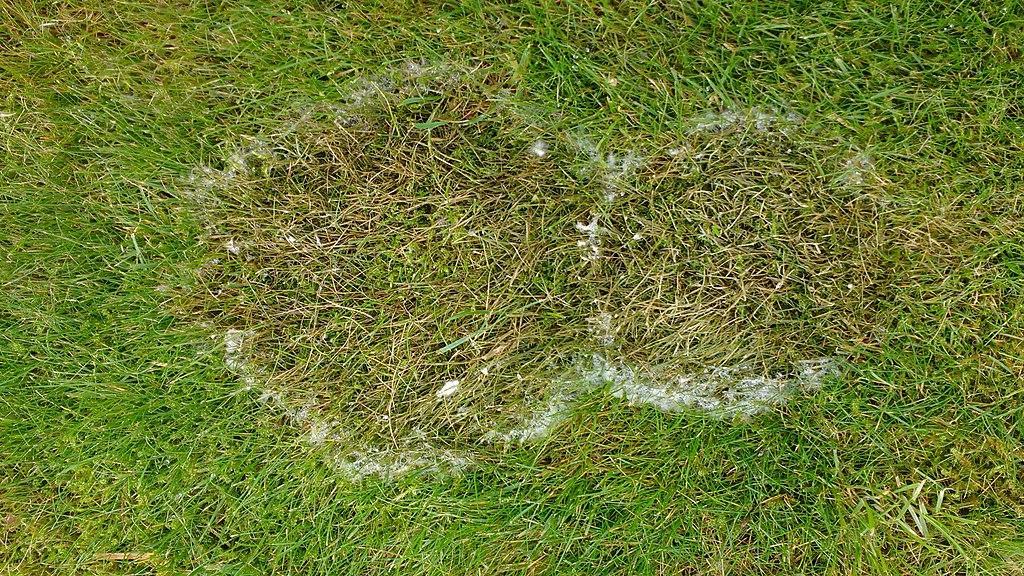
Pink snow mold: A law fungus that occurs under snow cover.
From highly obvious mushroom rings to odd-looking slimy areas on the turf, lawn fungus can manifest itself in many ways. Depending on the fungal disease, symptoms and signs will vary. However, you can examine your grass for the presence of white hair, squishy roots, and slimy dampness to see if you are at risk.
Other than that, here is a list of some of the most common signs and systems that might indicate a potential fungus problem in your yard and might need attention:
- Discoloration or distortion of grass blades
- Powdery or thread-like growths on and around the grass
- A wet, damp, greasy, or slimy-looking turf
- Presence of yellow, brown, red, or black spots on grass blades and stems
- Patches of brown or frayed grass without any apparent cause
- Presence of mushrooms or mushroom rings
Why Do I Have Fungus In My Grass?
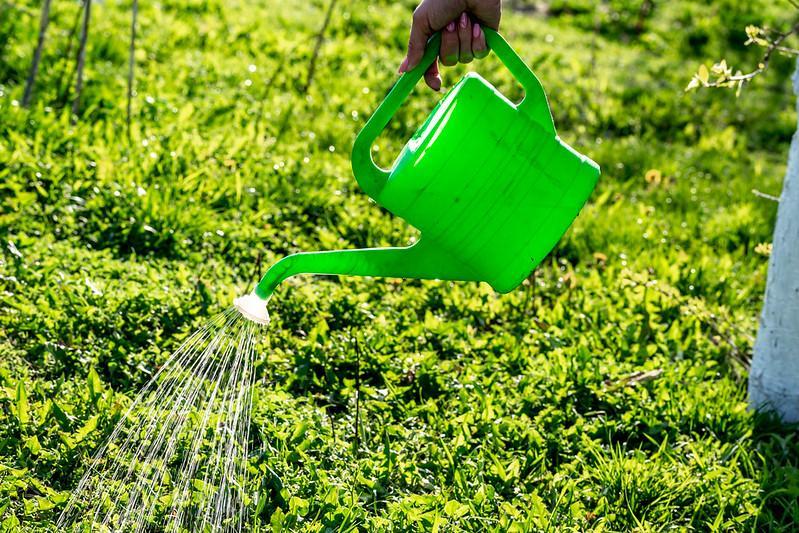
Overwatering is a common cause of fungal infestation of the grass.
Despite being portrayed as horrible villains of the turf environments, not all fungi are bad. In fact, they are very active soil organisms that decompose organic matter and return nutrients to the soil. Fungi and fungi spores are present naturally in the grass; some are pretty harmless, while others can make a mess of your grass.
However, it is usually not fungi but the wrong (or right) conditions that allow a lawn fungus to turn into a stuff of nightmares for lawn owners and gardeners. Lawn fungus usually attacks grass in times of distress, for instance, during rainy seasons, overwatering or even drought.
Nonetheless, for your ease, here is a list describing the most common causes of fungal diseases in the grass:
- Drought
- Overfertilization
- Undernourishment
- Humid weather conditions
- Overwatering
- Soil compaction
- Improper mowing
We will discuss the below-mentioned causes more in the portion ahead where we discuss individual fungal diseases of the grass.
Common Diseases Of The Grass
Now that you know what the causes and signs & symptoms of fungal diseases of the grass are, let’s go ahead and look at the few common ones. Make sure that you take your time while trying to identify a fungal disease on your lawn. Many fungal diseases have somewhat similar effects on the grass, and misinterpretation of the signs and symptoms is a common problem. So, take your time and read this guide thoroughly:
Pythium Blight
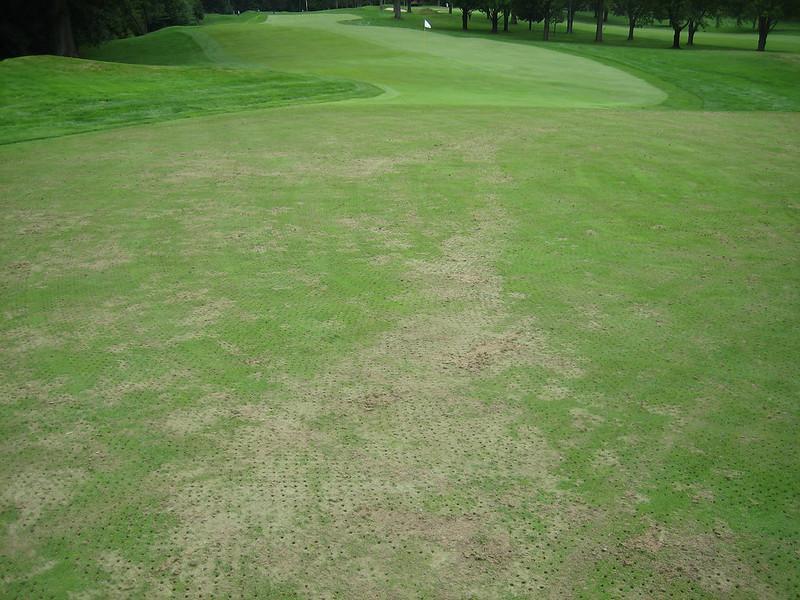
Turf grass riddled with Pythium blight.
Pythium blight affects both cool-season and warm-season grasses alike. The disease is especially damaging to perennial ryegrass, creeping bentgrass, and annual bluegrass. It spreads very quickly, affecting leaves, killing grass plants, and resulting in considerable damage to the turf. It is also known as cottony blight because the fungus-infested grass develops fluffy candy-like growths of white mycelium.
What causes Pythium blight?
Pythium blight is caused by various species of Pythium fungus. High humidity, rainy weather, warm nights, overfertilization, and poor drainage & aeration of the lawn can lead to a Pythium blight infestation.
How do you identify Pythium blight?
The disease can be readily identified by small patches of blighted grass that appear on the turf in wet and warm periods. In the early stages, grass appears slimy, soaked, greasy, and dark. As the disease progresses, cotton-like threads start appearing on the grass.
How do you get rid of Pythium blight?
The best way to treat Pythium blight is using Mefenoxam 2 AQ Fungicide. It is affordable and specially designed to kill harmful fungi, including Pythium blight. In addition, thatch is the best place for the active growth of Pythium fungus, so removing it will also help you control and prevent an infestation of Pythium blight on your lawn.
RELATED: Overseeding A Lawn With Weeds: A Simple And Easy Guide
Brown Patch
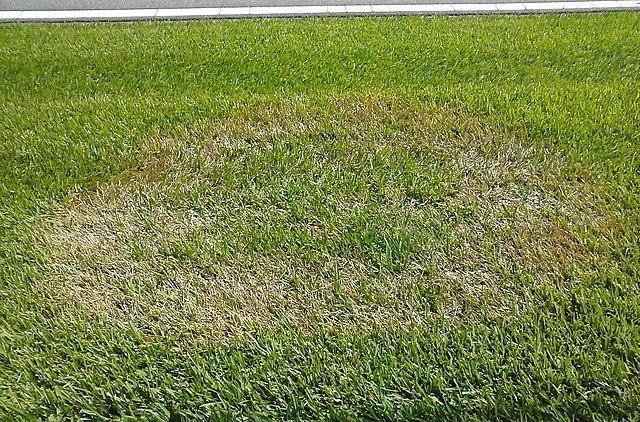
Brown patch of centipede grass.
It is one of the most common fungal diseases of many turf grasses. It affects nearly every species of cool-season turfgrass in the United States. However, it can also affect and damage warm-season grasses as well. Brown patch is a foliar fungal disease and does not cause damage to the roots or crown of the grass plants.
What causes Brown patch?
Brown patch disease is caused by species of the genus Rhizoctonia. The fungus usually attacks and thrives mid to late fall when the weather is cooling off. High levels of humidity also help the fungus spread and thrive better.
How do I identify a Brown patch?
In brown patch disease, circular, sunken patches of tanned or dead grass appear on the turf. These brown patches can be as large as 3feet in diameter. Once established, brown patch disease spreads very fast. In the final stages of the disease, turf starts to appear water-soaked, and leaf edges begin to wilt and curve.
How to get rid of Brown patch disease?
A fertilizer containing azoxystrobin and propiconazole as active ingredients is usually the best defense against brown patch disease. In addition to that, fertilizers containing fludioxonil as an active ingredient also work well against species of the genus Rhizoctonia.
However, use fungicides only as your last resort and try avoiding brown patch infestation by ensuring proper lawn care and adequately watering and fertilizing your lawn.
Fairy Ring
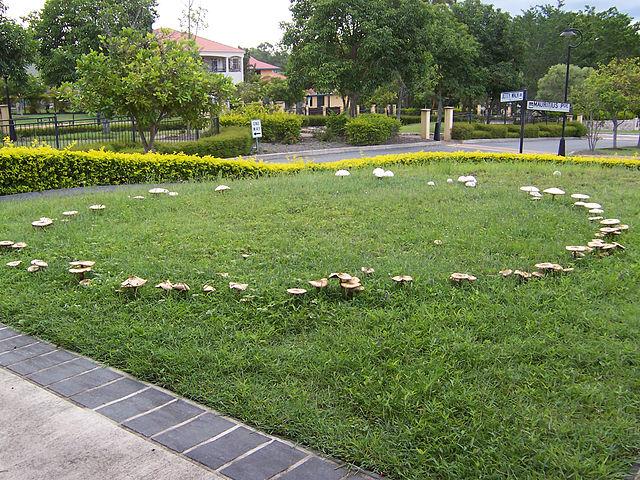
A fairy ring circle on a suburban lawn.
Fairy ring is a condition in which circular patches of dark green grass appear on turf with arcs or circles of mushrooms or dead grass around them. These rings can grow up to ten meters in diameter. The mushrooms in these rings help break down organic matter, which allows the grass to grow quicker.
What causes Fairy rings in lawns?
Even though many different species of fungi cause fairy rings, Maramius oreades is by far the most common species responsible for the development of fairy rings in both pastures and turf grasses. The disease is usually a result of thatch accumulation ion turf, which increases un-decomposed organic matter, thus promoting fungal growth.
How do you identify a Fairy ring?
If you see large, irregular patches of turf grass on your lawn, fairy rings might be the culprit. The patches may be dark green or tan. In addition to that, mushrooms and telltale puffballs also appear along the edge of the patch.
How do I get rid of a fairy ring on my lawn?
Getting rid of fairy rings is a bit of a chore. You can start by removing the mycelium-containing soil in and near the affected area. However, suppose the fairy ring only consists of mushrooms with no other visible symptoms. In that case, you can simply pull mushrooms like a weed and rake the grass over.
Dollar Spot
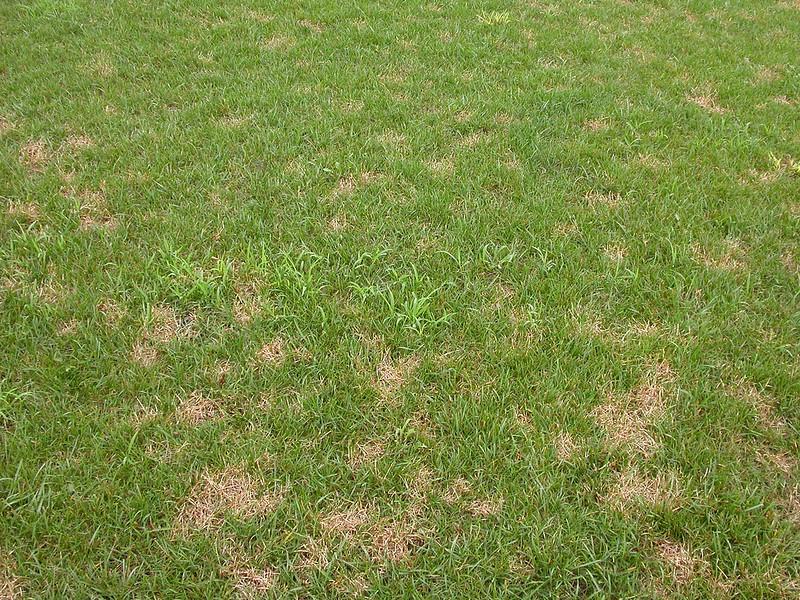
Dollar spots on a turf.
Another foliar disease on our list is the dollar spot. Like brown patch disease, it only affects leaf tissues but does not harm the roots or crowns of the grass plants. However, some evidence suggests that toxins produced by the fungus can damage grass roots. Dollar spot disease affects highly managed turf grass stands throughout the world.
What causes Dollar spots?
Dollar spot disease is caused by the fungus Sclerotinia homoeocarpa. It grows and infects susceptible grasses (tall fescue, zoysia grass, and Bermuda grass) when nighttime temperatures exceed 50°F. Soils deficient in nitrogen are especially prone to dollar spot disease. In addition to that, dollar spot disease is also encouraged by frequent irrigation, low mowing, and excessive thatch buildup.
How do you identify Dollar spots?
Dollar spot disease is not hard to identify. If you see spots of tanned grass roughly one inch in diameter, your grass is most likely affected by dollar spot disease. You might also see cotton-like thread arising from the grass blades in the early morning. Moreover, the spots also appear in clusters on the turf.
How do you treat Dollar spots?
Fungicides containing propiconazole and fludioxonil are usually the best way to get rid of dollar spots on a lawn. Once you get rid of dollar spots, core aeration, topdressing with organic material or mulch, and infrequent but deep watering can help you reduce the chances of getting a dollar spot infestation again.
Gray Leaf Spot
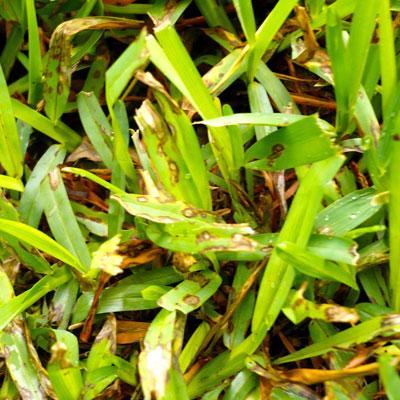
St. Augustine grass affected by gray leaf spot disease.
Gray leaf spot is the most severe foliar disease of corn, a grass, in the United States. However, the disease can affect turf grass species as well. Gray leaf spot spreads very quickly, so quick detection and elimination are of vital importance. The disease usually affects lawns in the first year of development.
What causes Gray leaf spot?
Gray leaf spot disease is caused by the fungus Pyricularia grisea. Prolonged rainy and warm weather boosts the growth of this fungus. The disease is also very destructive in such turfs that are in the shade or exposed to dappled sunlight for short periods.
How do you identify Gray leaf spot?
The disease starts in the form of small brown spots on the surface of grass leaves and stems. However, as the disease progresses, leaf spots turn dark and fuzzy with profuse spore production. In the later stages, leaf spots girdle the entire leaf and cause it to die from the root tip.
How do you treat Gray leaf spots?
You can start the treatment by pruning and removing the affected parts of your turf. In addition to that, fungicides containing azoxystrobin, pyraclostrobin, or fluoxastrobin can also be used. However, use them only as a last resort. First, try to recover the grass using neem oil and proper lawn care.
Pink Snow Mold
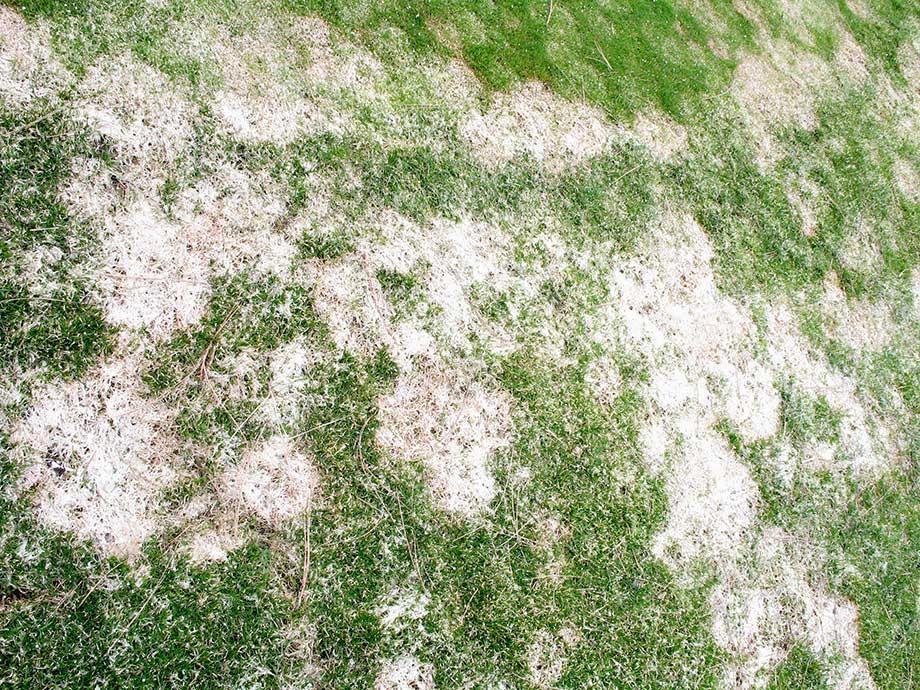
Late-stage pink snow mold on the turf.
Pink snow mold is a fungal infection that affects grass under snow cover during the winters. It nearly affects all cool-season turf grass species, especially those that are under a thick covering of snow from mid to late winter. The disease is most damaging to golf courses containing annual bluegrass and creeping bentgrass.
What causes Pink snow mold?
Pink snow mold is caused by the fungus Microdochium nivale. The disease is particularly troublesome during prolonged wet and cold periods, especially from autumn to early summer. The disease often stays dormant during the summer months and goes undetected, which can cause prolonged damage to the lawns.
What does snow mold look like?
The disease is first detected when the snow melts, and the turf underneath gets exposed. You can clearly see patches of pink, white or tan matted and dead grass on an otherwise green turf. The size of the patches varies from two to ten centimeters. In the later stages of the disease, fluffy white mycelium can also be seen on the grass blades.
How do you get rid of Pink snow mold?
The first thing to do is not allow snow to rest on your turf. Also, you can use thiophanate-methyl fungicide before the snowy season starts on your grass to save it from a fungal attack. Also, you can apply nitrogen fertilizer to the affected areas of the grass to promote grass recovery.
RELATED: How To Use a 2,4-D Lawn Weed Killer To Control Weeds? (And Is It Safe?)
Gray Snow Mold
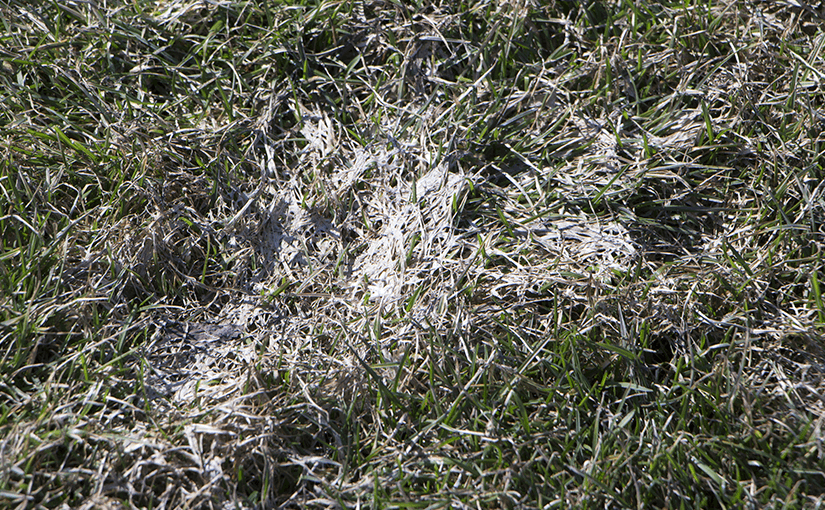
Gray snow mold disease.
Just like pink snow mold, gray snow mold also affects nearly all cool-season turf grasses in areas with extended periods of snow cover on the turf. However, compared to pink snow mold, the size and color of the patches are more prominent and darker, respectively.
What causes Gray snow mold?
The disease is sometimes referred to as typhula blight and is caused by the fungus Typhula incarnata. Extensive and prolonged snow cover is the most significant cause behind the development of gray snow mold on turf grass.
What does snow mold look like?
The first symptoms of the disease appear when the snow melts in the form of almost three feet wide tan colored patches of moldy grass. Within these patches, the grass blades are matted together.
How do you treat Gray snow mold?
Recovery from gray snow mold disease is extremely slow, and it can kill large patches of turf grass very quickly. So, it would help if you avoid getting the disease in the first place. Like pink snow mold, you can apply a fungicide to the grass before the snowy season begins and prevent snow from settling on your lawn for extended periods.
Summer Patch
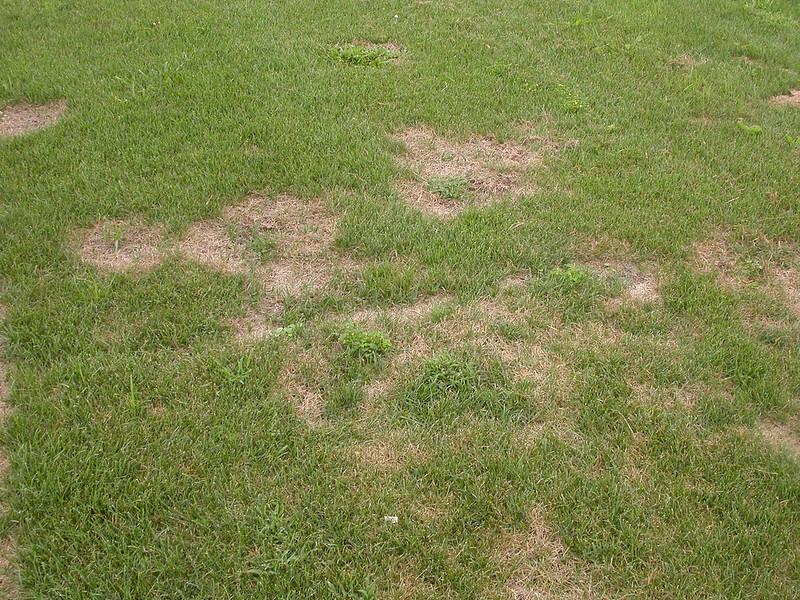
Summer patch disease.
Summer patch is a destructive disease of both golf courses and home lawns. The fungus infects and destroys grass roots, ultimately killing the plant. Summer patch disease is especially harmful to fine fescue grass, Kentucky bluegrass, and annual bluegrass. During winter, the disease stays dormant and undetected and affects grass when the warm season approaches.
What causes Summer patch disease?
Summer patch disease is caused by the fungus Magnaporthe (Magnaporthiopsis) poae. In addition to the grasses mentioned above, the fungus can infect various species of Poa and is the most crucial reason for the summer death of annual bluegrass. Heavy downpours, rainy season, saturated soil, and warm weather exacerbate disease development.
How to identify Summer patch disease?
Summer patch disease changes its appearance as it progresses. In the early stages of the disease, you might see wilted, dark green, irregular circles of grass that are around two inches in diameter. However, as the heat increases, these straw-colored rings, crescents, and patches increase in size. Affected grass can be easily pulled from the soil as well.
How do I fix my Summer patch?
To best treat and control the summer patch disease, you will need to apply a fungicide that is both curative and preventive. Also, fungicides in the case of summer patch disease are most effective when they are used as a preventative measure. Therefore, for best results, apply the fungicides when summer temperatures reach 65°F.
Red Thread Disease
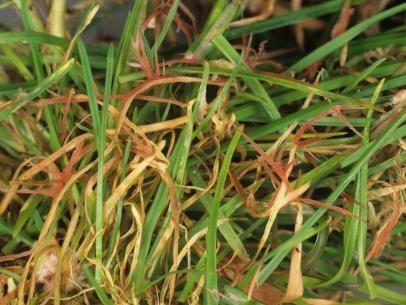
Red thread disease usually does not cause much harm to the grass.
It is a foliar fungal disease of such lawns that are usually mowed high during the spring and fall. The disease generally does not affect the lawn itself; however, it can make your lawn more susceptible to pests and other diseases. Moreover, red thread disease does not affect the roots and crown of the grass, so the damage is usually minimalistic.
What causes Red thread disease?
Red thread disease is caused by the fungus Laetisaria fuciformis. Rainy seasons during late spring and early summer boost the growth of this fungus. It is one of the most common lawn diseases in Pennsylvania.
What does Red thread fungus look like?
Red thread disease gets its name from the reddish antler-like outgrowths at the tips of infected grass blades by the fungus. It is not hard to spot. If you notice a reddish hue on your lawn grass, you are most likely dealing with red fungus. In the later stages, the patch might appear burnt or bleached.
How do you get rid of the Red thread?
Expert gardeners and lawn owners do not recommend chemically controlling the red thread disease. In fact, sometimes, the disease goes away on its own. Also, you can boost your recovery by properly fertilizing, aerating, and watering your lawn. However, you can use a herbicide containing strobilurins as your last resort in extreme cases.
Powdery Mildew
Other than grass, powdery mildew also affects a number of other plants. It usually does not cause much damage to the lawn unless correct conditions are met. However, the fungus does make the yard look very unsightly, which is not wanted for home lawns, sports fields, and other recreation turf areas.
What causes Powdery mildew?
Powdery mildew is caused by the fungus Blumeria graminis. The development of this particular fungus is boosted by shade, poor aeration, temperatures between 60 and 70 degrees F, and high humidity. Moreover, the fungus can also stay dormant in turf for extended periods of time if conditions are unfavorable.
What does Powdery mildew fungus look like?
If you see powdery spots of white to gray color on your lawn or felt-like mats or blotches on your yard, you are most likely dealing with the powdery mildew fungus. Green shoots and young leaves are the most affected parts of the plant. It is usually easy to identify the disease, and you will not mistake it for any other lawn fungus.
How do I get rid of the Powdery mildew?
Just like the red thread disease, powdery mildew is not much damaging to the lawn grass. However, it does look quite unsightly and can ruin the aesthetics of your lawn. Many commercially available fungicides can be used to treat powdery mildew in the grass. However, you should only use chemical treatment as your last resort.
Frequently Asked Questions (FAQs)
How do I get rid of the powdery mildew?
Although the proper treatment and fungicide will vary from fungus to fungus, here are a few things that you can do to treat fungus and boost the lawn recovery:
- Water your lawn deeply and infrequently
- Ensure proper aeration as fungi love compacted soil
- Ensure proper fertilization. Under and over-fertilization both can boost fungal growth
- Dethatch your yard regularly to prevent active fungal growth
- Use organic mulch or topdressing to ensure healthy soil
- Resolve drainage issues, and do not let your lawn stay wet
- Use sharp mowing blades and mow the grass at a proper height
What is the best fungicide for lawns?
Again, the best fungicide for a fungal disease will vary from disease to disease, just like the right or best treatment method for a fungal infection. In general, however, you should use a fungicide that is both curative and preventive. It is because fungal diseases can often cause extensive and long-lasting damage to the grass.
Nonetheless, below is a list of some of the best fungicides available on the market. Make sure that you read the complete product description before using them on your lawn.
- Heritage Granular Fungicide
- Dow AgroSciences 173917 Eagle 20EW Fungicide
- Scotts DiseaseEx Lawn Fungicide
- BioAdvanced 701270A Effective Fungicide
Will fungus go away on its own?
It all comes down to the type of fungus or fungal disease you are dealing with. In addition to that, whether or not a fungus will go away on its own also depends on the availability of the right conditions for its growth. However, you will need to treat the lawn fungus with fungicides more often than not.
It is because fungal diseases spread relatively quickly and can cause very severe and long-lasting damage to the grass if not treated on time. In addition, only a few types of fungus such as powdery mildew and red thread, usually go away on their own.
Does mowing spread fungus?
While mowing, fungus can stick to the mower blades and it can spread it all over your lawn from an infected area. It is the reason why professional gardeners and lawn owners do not recommend mowing a fungi-infested lawn. So, make sure that you clean the underside of the lawn mower on every use and set a proper mowing height for your yard to avoid spreading the fungus from one place to another.
Should I water the lawn before applying fungicide?
It is generally good to water the lawn before applying a system fungicide. The water helps the chemicals penetrate into the soil, which increases their absorption by the grass plants. This makes the treatment more effective.
However, once you have applied a fungicide to your lawn, we highly recommend that you do not water your lawn for at least 24 or 48 hours. It can wash off the chemical from the grass and decrease the effectiveness of the fungicide application to the yard.
Sources for Further Reading
- Diseases of Turfgrass: Identification and Management | Cooperative Extension | University of Delaware. (2022). Retrieved 18 May 2022, from https://www.udel.edu/academics/colleges/canr/cooperative-extension/fact-sheets/turfgrass-disease-identification/
- Turfgrass Diseases: Quick Reference Guide | UGA Cooperative Extension. (2022). Retrieved 18 May 2022, from https://extension.uga.edu/publications/detail.html?number=C891&title=Turfgrass%20Diseases:%20Quick%20Reference%20Guide
- Lawn Diseases | University of Maryland Extension. (2022). Retrieved 18 May 2022, from https://extension.umd.edu/resources/yard-garden/lawns/lawn-diseases
Hop you like our lawn fungus identification guide. Also, check out our other articles:
What Is Causing Bumps In My Lawn? And How To Get Rid Of Small Dirt Mounds!
How To Properly Aerate Bermuda Grass Lawn | Best Time To Aerate Your Bermuda Lawn
Most Effective Barriers To Keep Cars Off Grass | Stop Cars From Entering Your Lawn







